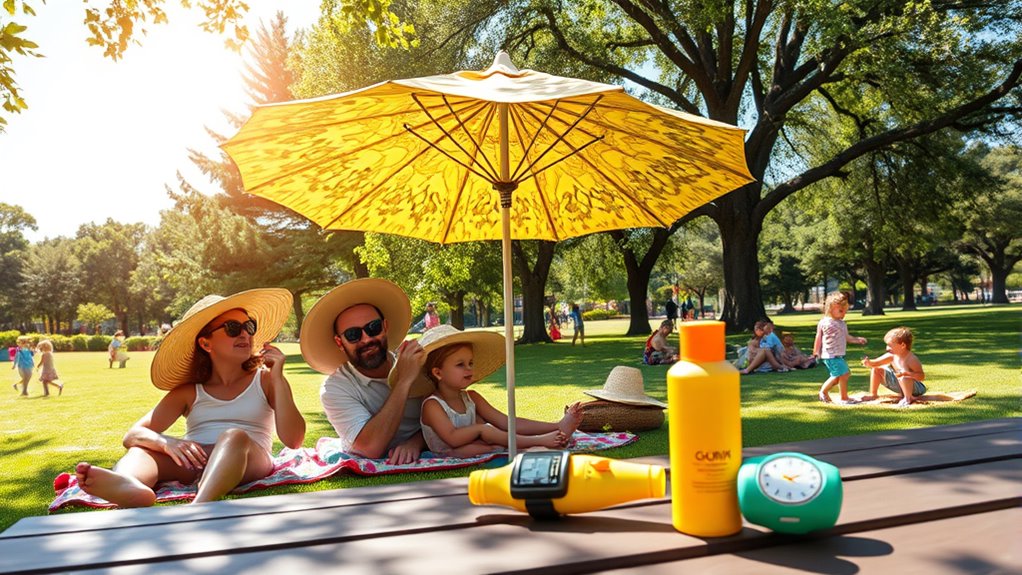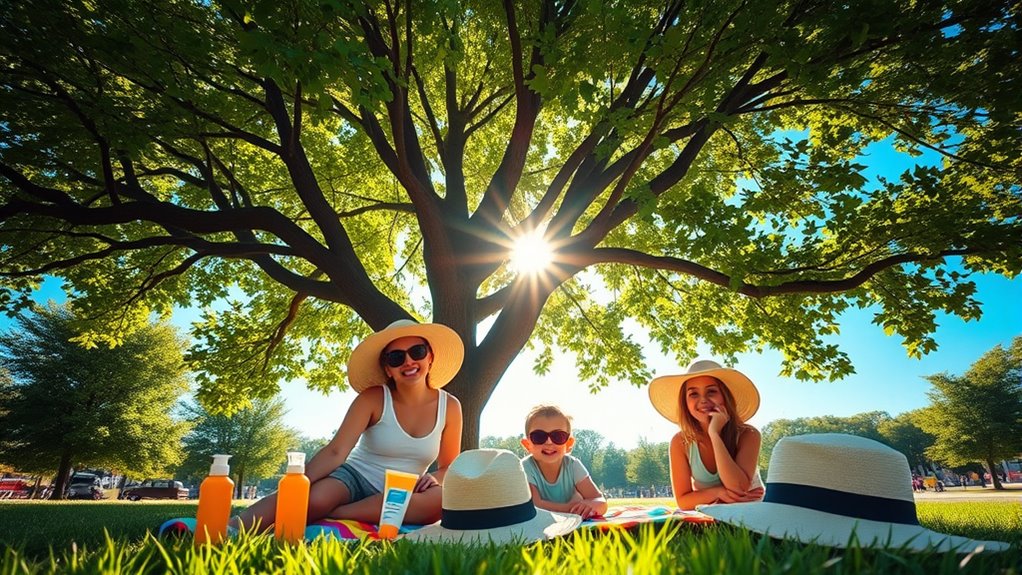To stay safe in the sun, use shade during peak hours, like from 10 a.m. to 4 p.m., when UV rays are strongest. Combine this with broad-spectrum sunscreen of SPF 30, reapplying every two hours or after sweating or swimming. Wear protective clothing, sunglasses, and hats for extra coverage. Planning outdoor activities outside peak times and consistently using these measures helps protect your skin. Keep going to learn more about how to maximize your sun safety routine.
Key Takeaways
- Seek shade during peak sunlight hours (10 a.m. – 4 p.m.) to minimize UV exposure.
- Use broad-spectrum SPF 30+ sunscreen, reapplying every two hours or after sweating/swimming.
- Wear protective clothing, wide-brimmed hats, and UV-blocking sunglasses during intense UV times.
- Plan outdoor activities outside peak hours and limit skin exposure during high UV periods.
- Remember that UV rays can reflect off surfaces like water and sand, so shade and protection are essential even on cloudy days.

Are you protecting your skin from the sun’s harmful rays? If not, it’s time to pay close attention, because UV radiation can cause serious skin damage over time, including premature aging and skin cancer. One of the most effective ways to shield yourself is by seeking shade whenever possible. When you’re outdoors, especially during peak sunlight hours between 10 a.m. and 4 p.m., look for trees, umbrellas, or canopies to reduce direct exposure. Shade acts like a natural barrier, blocking a substantial portion of UV rays before they reach your skin. Even if you’re just relaxing or walking around, staying under cover can make a big difference. Remember, UV rays can reflect off surfaces like water, sand, and concrete, so shade isn’t just about being under a tree; it’s about minimizing your overall exposure. Additionally, using proper sun protection techniques can further enhance your safety during outdoor activities.
In addition to seeking shade, applying broad-spectrum sunscreen should be a regular part of your sun safety routine. Choose a sunscreen with at least SPF 30, and don’t forget to apply it generously to all exposed skin. Use enough to cover evenly, and reapply every two hours, or more often if you’re sweating or swimming. Keep in mind that many people underestimate how much sunscreen they need—about a shot glass full for the body and a teaspoon for the face. Sunscreen acts as a barrier, absorbing or reflecting UV rays before they can harm your skin. It’s not enough to just put it on once; consistent reapplication is key, especially during prolonged outdoor activities. Make sure to cover tricky areas like your ears, the back of your neck, and the tops of your feet, which are often overlooked.
Timing your outdoor activities can also markedly reduce your risk. The sun’s rays are strongest between 10 a.m. and 4 p.m., so try to plan your outdoor errands or workouts outside of these hours whenever possible. If you need to be outside during peak sunlight, take extra precautions by wearing protective clothing, a wide-brimmed hat, and UV-blocking sunglasses. The goal is to limit your skin’s exposure to intense UV radiation, especially during the middle of the day when the rays are most potent. Remember that even on cloudy days, up to 80% of UV rays can reach your skin, so don’t skip sun protection just because the sky looks overcast. By combining shade, sunscreen, and thoughtful timing, you can enjoy the outdoors while keeping your skin safe from harm.
Frequently Asked Questions
How Often Should I Reapply Sunscreen During the Day?
You should reapply sunscreen every two hours when you’re outdoors, especially if you’re sweating or swimming. If you’re in the water or towel drying, reapply immediately afterward. Even on cloudy days, UV rays can harm your skin, so regular reapplication is essential. Make it a habit to reapply more often if you’re spending extended time outside, ensuring continuous protection against harmful rays.
What Are the Best Fabrics for Sun Protection Clothing?
You should choose fabrics like tightly woven cotton, polyester, or nylon for sun protection clothing. These materials are dense enough to block most UV rays. Look for specially treated fabrics labeled UPF 50+ for maximum protection. Avoid lightweight, loosely woven fabrics, as they let UV rays through. Wearing long sleeves and wide-brimmed hats made from these fabrics helps shield your skin effectively during outdoor activities.
Can Sunglasses Prevent Skin Cancer Around the Eyes?
Sunglasses can help prevent skin cancer around your eyes by blocking UV rays that damage the delicate skin in that area. Look for sunglasses that offer 100% UV protection to maximize this benefit. While sunglasses don’t directly prevent skin cancer, they shield your eyelids and surrounding skin from harmful rays, reducing your overall risk. Combine this with other sun safety measures for the best protection.
Is Natural or Organic Sunscreen More Effective?
Natural or organic sunscreens can be effective if they offer broad-spectrum protection and have an SPF of 30 or higher. However, some may not provide as much coverage or durability as conventional sunscreens. Always check the ingredients and choose one that suits your skin type. Reapply every two hours, especially after swimming or sweating, to guarantee you’re protected properly. Remember, consistency is key for effective sun safety.
How Does UV Exposure Vary With Different Weather Conditions?
On cloudy days, UV exposure drops but still reaches about 40% of direct sunlight, so you can still get sun damage. During overcast weather, UV rays scatter through clouds, increasing exposure. In foggy conditions, UV rays are markedly reduced but not eliminated. Bright sunny days pose the highest risk, especially between 10 a.m. and 4 p.m., when UV intensity peaks. Always check daily UV index forecasts to stay protected.
Conclusion
By embracing shade, sunscreen, and smart timing, you’re building a shield against the sun’s harsh rays. Think of these tools as your armor, guarding your skin like a gentle but unwavering guardian. When you take these simple steps, you’re not just protecting your skin—you’re preserving your health and radiance for years to come. So, step into the shade, slather on that sunscreen, and make sun safety your daily victory dance under the sky’s blazing sun.










